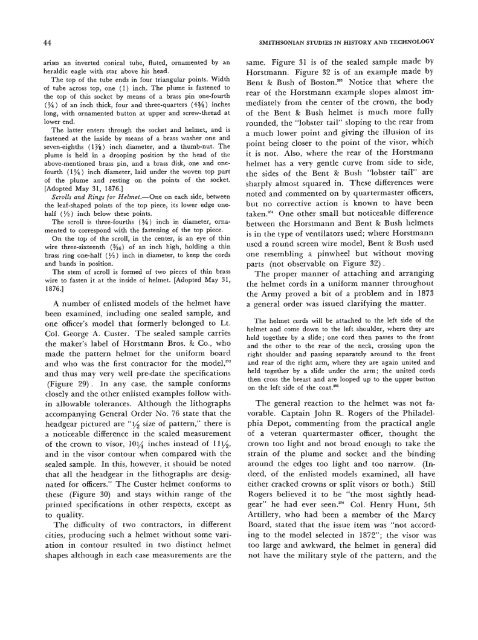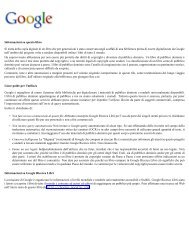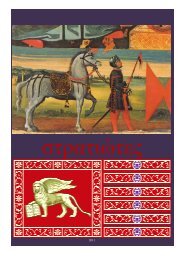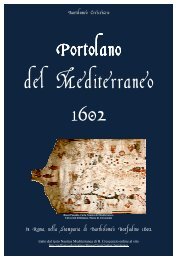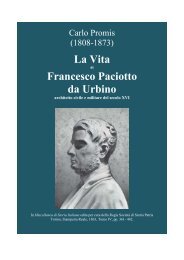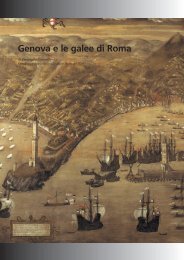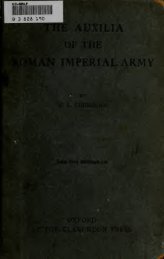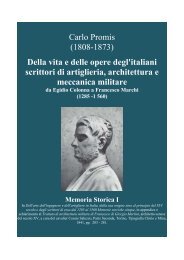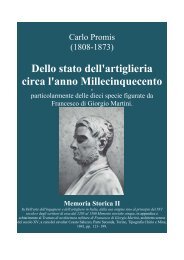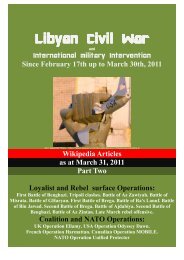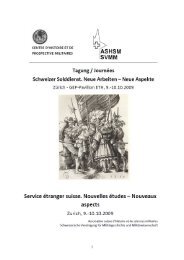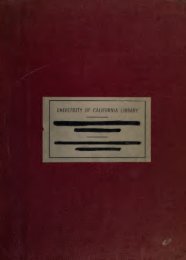United States Army Headgear 1855-1902 - Libreria Militare Ares
United States Army Headgear 1855-1902 - Libreria Militare Ares
United States Army Headgear 1855-1902 - Libreria Militare Ares
- No tags were found...
You also want an ePaper? Increase the reach of your titles
YUMPU automatically turns print PDFs into web optimized ePapers that Google loves.
44 SMITHSONIAN STUDIES IN HISTORY AND TECHNOLOGYarises an inverted conical tube, fluted, ornamented by anheraldic eagle with star above his head.The top of the tube ends in four triangular points. Widthof tube across top, one (1) inch. The plume is fastened tothe top of this socket by means of a brass pin one-fourth(Yi) of an inch thick, four and three-quarters (4^4) incheslong, with ornamented button at upper and screw-thread atlower end.The latter enters through the socket and helmet, and isfastened at the inside by means of a brass washer one andseven-eighths {lYs) inch diameter, and a thumb-nut. Theplume is held in a drooping position by the head of theabove-mentioned brass pin, and a brass disk, one and onefourth(154) inch diameter, laid under the woven top partof the plume and resting on the points of the socket.[Adopted May 31, 1876.]Scrolls and Rings for Helmet.—One on each side, betweenthe leaf-shaped points of the top piece, its lower edge onehalf(/a) inch below these points.The scroll is three-fourths (%) inch in diameter, ornamentedto correspond with the fastening of the top piece.On the top of the scroll, in the center, is an eye of thinwire three-sixteenth (%6) of an inch high, holding a thinbrass ring one-half (/a) inch in diameter, to keep the cordsand bands in position.The stem of scroll is formed of two pieces of thin brasswire to fasten it at the inside of helmet. [Adopted May 31,1876.]A number of enlisted models of the helmet havebeen examined, including one sealed sample, andone officer's model that formerly belonged to Lt.Col. George A. Custer. The sealed sample carriesthe maker's label of Horstmann Bros. &: Co., whomade the pattern helmet for the uniform boardand who was the first contractor for the model,'"and thus may very well pre-date the specifications(Figure 29). In any case, the sample conformsclosely and the other enlisted examples follow withinallowable tolerances. Although the lithographsaccompanying General Order No. 76 state that theheadgear pictured are "1/2 size of pattern," there isa noticeable difference in the scaled measurementof the crown to visor, IO14 inches instead of III/2.and in the visor contour when compared with thesealed sample. In this, however, it should be notedthat all the headgear in the lithographs are designatedfor officers." The Custer helmet conforms tothese (Figure 30) and stays within range of theprinted specifications in other respects, except asto quality.The difficulty of two contractors, in differentcities, producing such a helmet without some variationin contour resulted in two distinct helmetshapes although in each case measurements are thesame. Figure 31 is of the sealed sample made byHorstmann. Figure 32 is of an example made byBent & Bush of Boston.''' Notice that where therear of the Horstmann example slopes almost immediatelyfrom the center of the crown, the bodyof the Bent & Bush helmet is much more fullyrounded, the "lobster tail" sloping to the rear froma much lower point and giving the illusion of itspoint being closer to the point of the visor, whichit is not. Also, where the rear of the Horstmannhelmet has a very gentle curve from side to side,the sides of the Bent & Bush "lobster tail" aresharply almost squared in. These differences werenoted and commented on by quartermaster officers,but no corrective action is known to have beentaken."' One other small but noticeable differencebetween the Horstmann and Bent & Bush helmetsis in the type of ventilators used; where Horstmannused a round screen wire model. Bent & Bush usedone resembling a pinwheel but without movingparts (not observable on Figure 32).The proper manner of attaching and arrangingthe helmet cords in a uniform manner throughoutthe <strong>Army</strong> proved a bit of a problem and in 1873a general order was issued clarifying the matter.The helmet cords will be attached to the left side of thehelmet and come down to the left shoulder, where they areheld together by a slide; one cord then passes to the frontand the other to the rear of the neck, crossing upon theright shoulder and passing separately around to the frontand rear of the right arm, where they are again united andheld together by a slide under the arm; the united cordsthen cross the breast and are looped up to the upper buttonon the left side of the coat.^'The general reaction to the helmet was not favorable.Captain John R. Rogers of the PhiladelphiaDepot, commenting from the practical angleof a veteran quartermaster officer, thought thecrown too light and not broad enough to take thestrain of the plume and socket and the bindingaround the edges too light and too narrow. (Indeed,of the enlisted models examined, all haveeither cracked crowns or split visors or both.) StillRogers believed it to be "the most sightly headgear"he had ever seen."" Col. Henry Hunt, 5thArtillery, who had been a member of the MarcyBoard, stated that the issue item was "not accordingto the model selected in 1872"; the visor wastoo large and awkward, the helmet in general didnot have the military style of the pattern, and the


